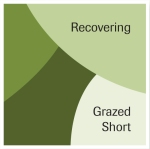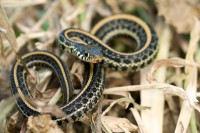ARE YOU GIVING GRASSLAND WILDLIFE WHAT THEY NEED?
Wildlife need a wide range of habitat types.
How does your ranch measure up?
Quality wildlife habitat and plant diversity can be maintained within many different grazing systems. The key is to create the full range of grassland habitat types, including very short and very tall. Grazing a pasture long enough to weaken dominant grasses creates important short-structure habitat but also gives new plants an opportunity to grow. Intensive grazing will not have lasting impacts on grasses as long as they are given sufficient recovery time. Allowing grasses to periodically grow to their full height makes great habitat but also builds deep roots. That root system helps grasses withstand drought and intensive grazing.
SHIFTING PATCHES OF HABITAT
Changing the location of habitat patches over time helps promote plant diversity and prevent the build-up of predators or diseases in any one place.

The shift of patch location happens naturally when areas are grazed intensively and then allowed to recover while others are grazed.
 Cross fences can target grazing pressure to specific areas. Burning one portion of a large pasture can also focus grazing pressure there. Unburned areas provided habitat, build fuel for future burns, and grow roots for future grazing.
Cross fences can target grazing pressure to specific areas. Burning one portion of a large pasture can also focus grazing pressure there. Unburned areas provided habitat, build fuel for future burns, and grow roots for future grazing.
While the process of intensive grazing and recovery is valuable, the periodic use of light stocking rates allows cattle to graze selectively and create important mixed-height structure for birds, reptiles, and insects.
WHY ARE ALL THESE
HABITAT TYPES IMPORTANT?
Every wildlife and invertebrate species has its own individual habitat requirements. Some spend their whole life in one type of habitat structure, but many need multiple habitats. For example, prairie chickens like very short grass for courtship behavior, nest in relatively dense grassland, and prefer to raise their broods in mixed-height or weedy vegetation where the chicks can run around the ground beneath a canopy of protective cover. Abundant wildlife depends on a diversity of habitat types.
Providing a mixture of habitat patches also helps ensure the survival and reproduction of plant species. For example, creating tall dense habitat requires a period of rest, which favors a number of plant species that are not well-adapted to frequent grazing. Other plant species flourish after intensive grazing temporarily weakens the grasses they compete with and then fade away as those grasses recover their vigor. Many of those opportunistic plant species (including annual sunflowers, ragweeds, verbenas, and others) are also very important for wildlife species as both cover and food. Encouraging plant diversity on your land provides a consistent and abundant supply of food for wildlife and invertebrates. It can also improver productivity by ensuring the presence of green, vibrant plants throughout every season, even during very dry or very wet periods.
Both plant diversity and habitat structure are important for invertebrates. Bees rely on consistent sources of pollen and nectar-producing flowers throughout the entire growing season, something only a diversity of plant species can provide. Plant diversity also boosts the number of insect species, including many that contribute to soil health, control of pest species , and other crucial roles. Finally, insects need a good mix of sun and shade to help them regulate their temperature, so many thrive in mixed-height and weedy habitats.
View our brochure on grassland management.











